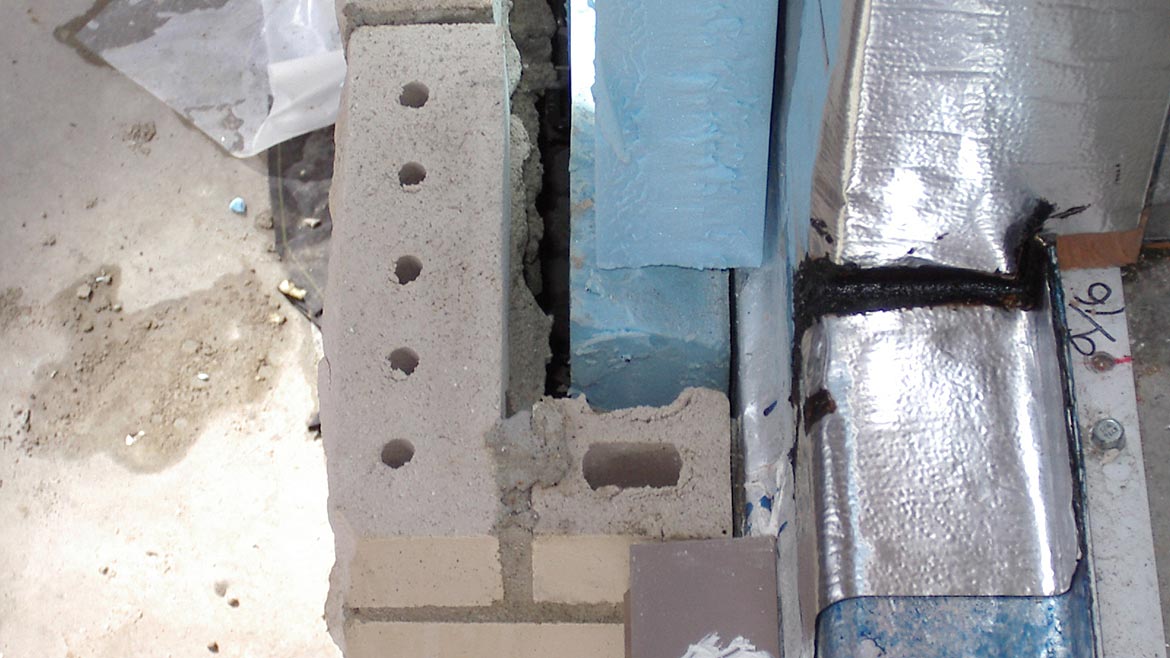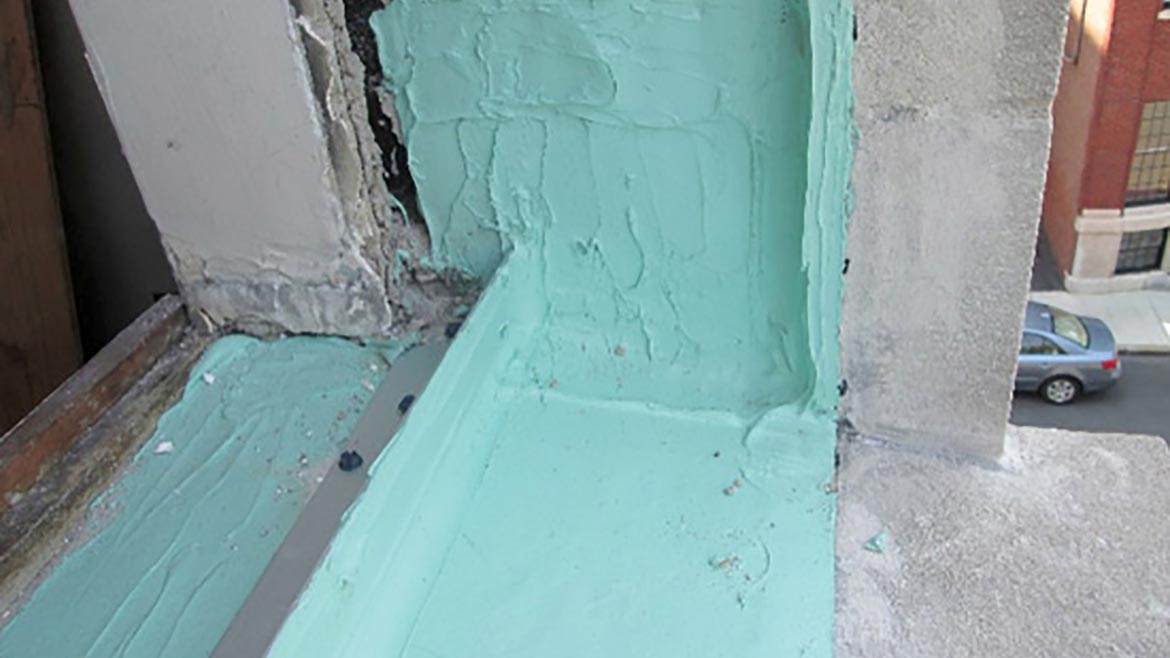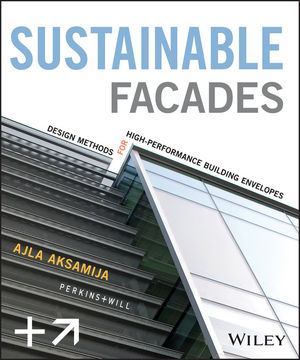As codes tighten and building owners demand more sustainable, near-zero-energy buildings, meeting regulatory requirements for energy efficiency is a significant challenge. Air infiltration is the third leading contributor—18 percent—to the energy loads required to maintain a set interior temperature (U.S. DOE 2005).
Reducing air infiltration is one key to decreasing the energy requirements for heating and cooling. Installing innovative high-tech weather barrier systems helps address the performance needs of modern building construction. Beyond air barrier considerations, openings in the façade also must be flashed correctly to minimize air infiltration and avoid water intrusion, indicative of the need for a complete weather barrier system.
Complying with energy code requirements also may require a split-insulation strategy in which vapor-permeable capabilities are key for wall assembly breathability and, by implication, long-term durability. This strategy involves a wall assembly with both cavity-filled insulation and continuous exterior insulation. The need for thermal control—particularly at interface locations—in addition to continuity of the air and water control layers adds further complications.
In response, many weather barrier substrates have been introduced to the market under a range of terms—air barriers, vapor barriers, peel-and-stick membranes, foil face flashing and fluid-applied membranes. Each is marketed as meeting building codes and standards, but with various degrees of success. And, on top of specific code requirements, the success of a WRB also can depend on its ease of use and the confidence it instills in both the specifier and the installer.
With the wide variety of air barrier materials on the market, an understanding of the available options and their general performance attributes and specific challenges is important—as is the need to maintain a holistic perspective of how these materials will work together.
 Figure 1: Self-adhered membrane installation at window opening—multiple layers and sequencing implications.
Figure 1: Self-adhered membrane installation at window opening—multiple layers and sequencing implications.Image courtesy of Dow.
Sheet-applied vs. Fluid-applied Barriers
Sheet-applied Barriers
Choices in the sheet-applied category can be divided into two basic subcategories: mechanically attached or self-adhering. The challenges associated with mechanically attaching an air barrier include impact on performance and the ease of installation, which ultimately affect long-term durability.
Mechanical attachments—and the holes made in the air barrier during their installation process—can lead to uncontrolled air and water infiltration. Functioning as a continuous air barrier is a requirement for optimal air barrier performance and long-term durability. To achieve this, the lapped joints at the sheet material’s edges should be sealed – either taped or affixed with a self-adhering backing. Self-adhered air barrier materials often come in the form of an asphaltic-based sheet laminated to a high-density polyethylene or metalized liner. Typically, these materials require a primer for long-term adhesion, which adds labor, time and materials.
Either type of the sheet-applied system can be done satisfactorily, but they typically require more attention to detail and advanced knowledge of how the transition conditions to adjacent systems, such as windows, will be managed. These transitions often require another suite of materials, which raises concerns related to sequencing, compatibility, adhesion and movement capacity.
Fluid-applied Barriers
With greater flexibility in the types of substrates to which they can be applied, fluid-applied air barriers simplify installation on more complicated construction projects. For instance, a fluid-applied barrier would be well-suited for a wall that transitions from a concrete knee-wall to a framed wall that transitions laterally to a concrete masonry unit wall—a combination readily found in commercial construction.
In addition to the benefit of substrate compatibility, silicone liquid-applied air barriers – particularly those that are water-based—offer primer-less adhesion to most construction substrates. This minimizes labor and additional product costs within a low-volatile-organic-compound formulation.
Liquid-applied barriers typically are segmented by thickness of application:
Thick-mil systems use more material and have lower yields per gallon of material purchased. Hence, they typically are more expensive on a per-square-foot-installed basis. Moreover, achieving the required thickness is challenging, as the material can begin to slough during application if upper-end thickness is not monitored.
Conversely, thin-mil systems leave little margin of error for the applicator and make it difficult to guarantee there is sufficient material on the wall for long-term performance.
Liquid-applied membranes in the range of 15-mil dry film thickness offer sufficient material application for uniform coverage and performance, while not risking sloughing of material due to high buildup during installation.
Additionally, some barrier products are marketed as having self-sealing properties, but those claims should be verified with the system manufacturer—especially in terms of fastener size and testing considerations.
 Figure 2: Liquid flashing installation at window opening—single material and installation operation.
Figure 2: Liquid flashing installation at window opening—single material and installation operation. (Image courtesy of Simpson Gumpertz & Heger – Waltham, Massachusetts)
Energy Codes and Air Barrier Permeability
If the exterior wall design calls for a fully continuous exterior insulated wall, the oft-referred-to “perfect wall” can offer an easy answer. However, the potential for higher costs associated with advanced engineered solutions poses challenges to some projects.
Both ASHRAE 90.1-2013—Energy Standard for Buildings Except Low-Rise Residential Buildings and the International Energy Conservation Code mandate inclusion of continuous insulation, essentially directing a design that includes stud cavity-filled insulation along with the minimum required CI. Air barrier permeability—which enables wall assembly breathability—and long-term durability are especially important in these situations.
Beyond the Material: A System Approach
Taking a more holistic approach to wall assembly design and material selection brings other factors to the selection process. Like water penetration resistance and thermal resistance, airtightness is only as good as the weakest link in the entire wall assembly. The migration of moisture vapor into a wall cavity is substantially more evasive and damaging when accommodating full movement capacity than the effect of the diffusion alone. The airtightness at these transitions often is more important than the airtightness and actual permeability of the air barrier itself.
By using a system-based air barrier, many of these concerns can be addressed. Liquid-applied silicone air barrier systems typically are easy to apply and come with a suite of compatible silicone-based accessories. Use of a compatible liquid flashing mitigates the infamous “origami” of sheet-based systems at window rough openings. Liquid flashing—particularly when primer-less application is acceptable—also saves time in comparison to sheet-applied materials or liquid flashing materials that require an embedded mesh reinforcement. Readily available silicone transitions do not have the concerns associated with acrylic- or asphaltic-based materials.
System-based weather barriers deliver simplicity for specifiers and project managers, easing the decision-making process. With the benefit of a single manufacturer of the barrier components, designers can be confident the system will collectively work for the wall assembly design without compatibility concerns, enabling flexibility in project sequencing. Availability of supplemental, fully compatible accessory materials adds even further flexibility.
Controlling air leakage—whether from the outside in or from the inside out—is critical for building enclosure performance and long-term durability. Selecting the correct WRB for a given project is a decision that should be based on a number of factors, including permeability, component compatibility, performance and ease of application.
References
BSI-001: The Perfect Wall, Building Insights, Joseph Lstiburek, Building Science Corporation, buildingscience.com/documents/insights/bsi-001-the-perfect-wall
ASHRAE – American Society of Heating, Refrigerating and Air-Conditioning Engineers, ashrae.org
IECC – International Energy Conservation Code, iccsafe.org









Report Abusive Comment